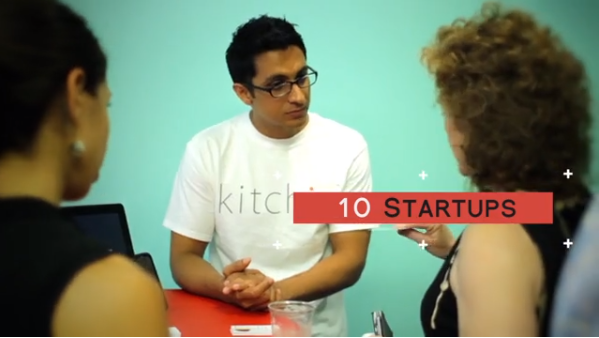
by Tim Hines | Apr 14, 2014 | Startups, Tech
For many entrepreneurs that are tired of working from home, the corner coffee shop has become a haven for getting plugged-in to get productive with laptops out and headphones on. I can see why many entrepreneurs make coffee joints their place of biz; they’re from open morning til night, offer a warm atmosphere and have plenty of startup fuel flowing. However, I personally have never been a fan of this work environment and have not fallen under the spell of the cafe mystique. Leaving reeking of the smell of coffee grounds is not all it is cracked up to be. I say its time to realize what the coffee shop is good for: grabbing a cup of coffee, and conversing with friends, or reading a book in leisure. Its not the place to get your startup started and I have five reasons why.
1. It’s Distracting – All entrepreneurs can agree that focus is key to success. How can anyone concentrate for a full work day in an environment of chatting, bean grinding, and brew whooshing? Not to mention the overly-loud music filling the room; most prominent at Starbucks where music labels are forcing music down your ear canals in hopes of a purchase with your latte. If you do plan to work in these distractions, invest in some noise-cancelling headphones and blinders to keep your eyes on your laptop. Just pray no one bumps the back of your chair, asks to sit at your table or spills something on you.
2. It’s Unprofessional – I have never been a fan of taking meetings at coffee shops, mostly because of reason #1 above, but in all seriousness, its just unprofessional. Sure, it depends on whom you’re meeting with and your relationship with them. I would hope entrepreneurs would never schedule an investor pitch meeting at a Caribou. Coffee shops can be a logistical nightmare for meetings, even if they’re quick. There’s nothing worse than scheduling a meeting, showing up and not having a place to sit to conduct your meeting. Fail.
3. It’s Un-Collaborative – There may be other startup junkies in your vicinity at Intelligentsia, but since they are also desperately trying to stay focused they’re not exactly open to having collaborative discussions. Contrast to the environment at a real co-working space that promotes and breeds collaborative behavior like 1871 or the Inspire Business Club. There, it’s acceptable to join forces with other startup geeks and not have to worry about someone stealing your seat if you need to use the rest room.
4. It’s Expensive – The average latte in Chicago costs $4 and if you buy one a day that adds up to be $120/moth and $1460/year. That’s an expensive habit for bootstrapping entrepreneurs. With that money you’re spending on coffee you could afford most open-seating co-working spaces and those typically include a warm caffeinated beverage. Good luck trying to get away without making a purchase, they’ll toss you out for loitering.
5. It’s Lacking Resources – I have yet to see a barista hand over an entrepreneur mail deliveries with his caramel macchiato. Not gonna happen. You can’t have mail sent to Starbucks; you wouldn’t use their address for your business; and they probably don’t have a fax machine you could borrow. Sure they have free Wi-Fi, but its not and will never be an office. Try reserving group of tables ahead of time to have a group brainstorming session. Nope!
These reasons may be my opinions, but you gotta admit, they have some merit. I’m not saying to not frequent coffee shops, they are local businesses that need our support. I’m just saying to think twice before working there. A coffee shop may be a fine escape every once in a while, but I recommend to find a place that you can be most productive with your startup. Kudos to you for at least getting out of the house.

by Tim Hines | Aug 28, 2013 | Startups, Tech
Last month I had the privilege to represent one of five companies that took the stage during Technori Pitch on July 28th. After weeks of prep and an intense coaching session with Brian Burkhart of Square Planet, we were ready to go. Here is the video from the pitch event that drew over 500 Chicago startup lovers…

by Tim Hines | Aug 26, 2013 | Startups, Tech
Have you seen the Built in Chicago map of Chicago startups lately? It’s exciting to see how many awesome startups are calling Chicago home and being plotted on the map. With an estimated one new company being started every 48 hours in the Windy City, it is likely difficult to keep that map up to date.
I, much like most of you, have come to know River North as the stronghold of Chicago’s startup and tech seen with 1871 being the anchor. Follow the brown line up from the Merchandise Mart and you’ll notice tech company after tech company dotting the River North landscape. San Francisco may have Silicon Valley; New York may have the Silicon Alley; but we in Chicago have the Silicon Railway (the stretch of L tracks from the Mart to the Chicago stop). Many of you know the folks that call that area home: SpotHero, Techweek, Groupon and Trunk Club to name a few. There are dozens upon dozens of companies in this amazing neighborhood of ingenuity and entertainment.
While most of the meetings you may attend and events you may crash are hosted in this area, its important to recognize that that not all that is ‘happening’ in Chicago startups/tech is going down in River North. There are many neighborhoods that startups call home in this great city, but one in particular is the West Loop, or the west extension of the Silicon Railway, and it’s booming.
Many household names like Sandbox Industries (on Racine Av.), Crowdspring (on Lake St.) and Threadless (on Madison St.) make the once meat-packing capital of the Midwest their stronghold. With numerous office lofts and co-working spaces, the West Loop is becoming a more and more a vibrant part of the Chicago tech and startup community. If the startup migration to this hood wasn’t enough to persuade you, this might: Google is leaving their River North HQ for greener pastures off the Green Line. Once the tech giant has finished building out its new stronghold on Fulton St., the West Loop will be home to their Chicago operations.
A recent CBRE analysis showed that many tech companies are vying for space in the West Loop as prices continue to climb in River North. This is simple supply and demand. 1871 alumni are rapidly moving into spaces in River North and prices are skyrocketing, while space in the West Loop remains competitive.
Events are also becoming more frequent. Earlier this year, Lightbank hosted their Innovation Day with amazing content and speakers in the West Loop at City Winery. UIC holds many startup events at their new Innovation Incubator and will be playing host to Startup Weekend later this year. There’s also the month Inspire Startups Showcase & Pitch that I coordinate at the Inspire Business Center. As you can tell, the West Loop is an important part of Chicago’s booming startup scene.
I created a list of events, work spaces and companies that call that are headquartered in the West Loop. If I missed you, don’t worry; post your company’s name in the comment section and help give the West Loop the recognition it deserves.
Events:
Co-Working Spaces:
Companies:
- 37 Signals
- AdGooroo
- AttorneyFee.com
- Autumn Berry Inspired
- Bloom Health
- Braintree
- BTSocial
- Central Street Games
- Concept Feedback
- CrowdSpring
- CurbNinja
- Coupon Doc
- CookItFor.Us
- Demibooks
- Digital Bridge
- Dine
- Element Bars
- Epic Burger
- FoodJunky
- Furywing Games
- GeneXus
- Give Forward
- Gorilla (72)
- Goshi
- KitchIn
- Knowledge Shift
- West Loop Ventures
- Lasso
- My Short Track
- Power2Switch
- Reppio
- Sandbox Industries
- Savvo Solutions
- Signal HQ
- Skinny Corp (aka Threadless)
- Sollywood TV
- Sprout Social
- We Gather

by Tim Hines | Aug 12, 2013 | Startups
[vc_row][vc_column][vc_column_text]I have been coordinating the monthly Inspire Startups showcase since February and we are excited to be hosting our fifth showcase and pitch event on Aug. 21. Since the first event, we have had 40 companies, 4 excellent speakers and over 300 attendees come though the IBC doors. With all that excitement, we thought it would be fitting to produce a video that showed off the Inspire Startups format. With thanks to the guys at Brin Hill Media and SollywoodTV, here’s the debut!
See more about the Inspire Startups project on my Projects page.[/vc_column_text][vc_raw_html]JTNDaWZyYW1lJTIwc3JjJTNEJTIyaHR0cHMlM0ElMkYlMkZwbGF5ZXIudmltZW8uY29tJTJGdmlkZW8lMkY3MjE5MTIyOSUyMiUyMHdpZHRoJTNEJTIyNjQwJTIyJTIwaGVpZ2h0JTNEJTIyMzYwJTIyJTIwZnJhbWVib3JkZXIlM0QlMjIwJTIyJTIwYWxsb3dmdWxsc2NyZWVuJTNFJTNDJTJGaWZyYW1lJTNF[/vc_raw_html][/vc_column][/vc_row]

by Tim Hines | May 7, 2013 | Startups
Maybe you have attended a zillion Chicago startup events like BIC Launch, TechCocktail, or Technori Pitch to network and learn about the community. And maybe you found yourself gawking at startup teams that came dressed for the event wearing their company’s swag and thought, “That’s awesome! How do I get shirts for my startup?”
We boot-strappers know that every penny needs to be carefully spent and maxing out our credit card ordering t-shirts just doesn’t make sense. We also understand that our shirts need to be just right to convey our brand message while looking cool. And believe it or not, there is a certain unspoken standard you should abide by.
From experience with my startup, I have devised these four easy tips to make a great startup t-shirt.
1. STAND OUT – Pick a style and color that will get you noticed. Hopefully you already chose a bright color for your brand that will easily translate into shirt form. If not, pick a close color or iterate your logo/image to work with the shirt color. Thankfully, with BTSocial, we used organge as our main color which really stands out at events. Not to step on any toes, but blue is way overdone. The biggest tech companies all have blue in the brand sceme. Be bold and different. I think yellow looks really nice this time of year.
2. KEEP IT SIMPLE – We’re not talking about printing a whimsical graphic T or some amazing rendering from Threadless. You just need a simple and clear representation of your brand that people can understand. Ideally, it would be good to translate your logo to solid white and print it on your bright colored shirt. Not only is this easy on the eyes, but also saves you on multi-color printing costs. The folks at SpotHero are all about this. Your design should also be easy to read and not too wordy. Your logo and call to action are good, but don’t overdo it with a long tagline in a small font that’s too hard to read, requiring us to practically bury our face in your chest. Awkward.
3. USE THE BACK – Your shirt has a lot of real estate and while it shouldn’t be overused, it also shouldn’t be wasted. Many companies also do back printing, so add something to the back across the shoulder blades so that even when your back is turned you’re showing off your brand. With our BTSocial shirts, we put our website address on the back. It’s also fun to turn around and show people the back in conversation.
4. COORDINATE YOUR TEAM – When you’re heading to an event with your startup, whether you’re pitching or not, have everyone wear their shirt – its obviously a great way to get noticed. Now, not all events are suitable for your shirts. Some are formal and require a tie, so throwing a sport coat over your t-shirt to make a Silicon Valley Tuxedo is not always acceptable. Look at your industry for best practices. Also, if you are going to a lot of events and wearing your shirts frequently, make sure they are clean. This should really go unsaid, but don’t wear the same exact shirt in the sweaty summer heat to TechWeek. People will notice those pit stains!
So this is great, but where can you get your shirts made? As you already know, there are many companies that print shirts, but most can be VERY expensive and often require high minimum orders. If you only need eight shirts (say three for your team and five to give away) then your options are limited as most printers require twenty or more.




